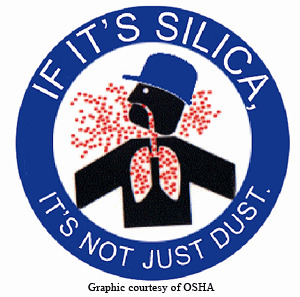
At Health Science Associates, protecting workers’ health is our mission.
One of the most serious yet often misunderstood hazards in many Southern California industrial, construction, and manufacturing settings is crystalline silica. Without proper respiratory protection, exposure to silica dust can lead to lifelong, irreversible diseases.
In this article, we’ll explain what silica exposure is, why it’s dangerous, what regulations require, how a proper PPE mask (respirator) helps, and what employers and workers must do to stay safe.
What Is Crystalline Silica and Where Is It Found
Crystalline silica is a mineral commonly found in sand, quartz, concrete, brick, stone, and many construction or finishing materials. When these materials are cut, ground, crushed, or otherwise disturbed, they generate extremely fine particles known as respirable crystalline silica dust. This dust is so small that it can penetrate deep into the lungs.
In California and across the U.S., many workplaces include silica exposure risks in:
- Welding
- Fabrication
- Masonry
- Cutting countertops
- Tunneling
- Abrasive blasting
According to OSHA, construction tasks like sawing masonry, drilling concrete, grinding mortar, and using jackhammers are among the activities that release respirable crystalline silica.
Health Risks from Silica Exposure
Breathing in respirable silica dust over time can lead to serious, irreversible conditions, including:
- Silicosis (a lung disease marked by inflammation and scarring, reducing lung capacity)
- Lung cancer
- Chronic obstructive pulmonary disease (COPD)
- Kidney disease
Silica is classified by OSHA and the International Agency for Research on Cancer (IARC) as a human carcinogen.
Because symptoms often take time to develop, many workers may not realize a problem until lung damage is advanced. Prevention is the only practical safeguard.
Regulatory Standards & Exposure Limits
Silica exposure is tightly regulated under U.S. law. For general industry and construction, OSHA’s standard sets a permissible exposure limit (PEL) of 50 micrograms per cubic meter (µg/m³) of respirable crystalline silica averaged over an 8-hour shift.
To reduce silica exposure to or below the PEL, employers must also implement engineering and work-practice controls such as:
- Wet cutting,
- Local exhaust ventilation
- Dust suppression systems
If those controls are not sufficient, respiratory protection must be provided.
In California, state regulations also require adherence to Title 8 silica rules, which mirror or exceed federal standards and impose additional responsibilities on employers.
Failure to comply can lead to citations, fines, or legal liability, but more importantly, it places worker health at grave risk.
Why a Proper PPE Mask (Respirator) Is Critical
A respirator or mask designed for silica dust can filter out harmful particles before they enter the lungs, but only if it’s correctly selected, fitted, and maintained.
Key factors include:
- Certification: Only NIOSH-approved respirators should be used.
- Assigned Protection Factor (APF): Different respirator types (N95, P100, powered air-purifying respirators, supplied-air units) provide differing levels of protection depending on silica concentration. For example, NIOSH guidance shows that an N95 respirator (APF = 10) is appropriate only up to certain dust levels.
- Fit testing & facial seal: A respirator must seal properly to your face. Facial hair or a poor fit interferes. OSHA requires employers to conduct fit testing and training.
- Maintenance & replacement: Filters, cartridges, and seals degrade; they must be cleaned or replaced per manufacturer guidelines.
- Use only when required: Legally, respiratory protection is a supplement. Employers must still pursue dust controls first, not rely solely on masks.
When respirators are used improperly, whether it be the wrong type, poor seal, or worn-out filters, they fail to protect workers, creating a false sense of safety.
Common Mistakes & Gaps in PPE Use
Here are pitfalls we often see in workplaces:
- Using a dust mask or surgical mask (not NIOSH-certified) instead of a respirator
- Ignoring fit testing or allowing facial hair
- Reusing cartridges past their service life
- Failing to match respirator type to dust concentration (undermasking)
- Relying entirely on PPE and neglecting dust control measures
These gaps are dangerous. As OSHA guidance states, respirators must be part of a comprehensive plan, not the sole means of protection.
What Employers & Workers Should Do
To mitigate silica risk, every employer and worker in silica-exposure jobs should collaborate on:
- Exposure assessment / air monitoring
- Choosing and enforcing engineering & administrative controls
- Developing a written exposure control plan
- Providing respirators when needed (with fit testing, training, maintenance)
- Instituting medical surveillance / health exams
- Training workers on silica hazards, safe practices, and respirator use
- Keeping exposure records, monitoring effectiveness, and updating protocols regularly
The CDC / NIOSH Safe Work Practices guidance emphasizes that protection must be layered: controls first, PPE second.
At Health Science Associates, we assist companies in designing exposure control plans, selecting proper respirators, testing workplace air, and training staff to use PPE correctly.
Final Thoughts
Silica exposure without proper PPE protection is a serious and preventable risk. Over time, respirable silica can lead to irreversible lung disease, cancer, and systemic harm.
Regulations exist to limit exposure, but compliance depends on practical implementation: controls, proper respirators, training, monitoring, and medical surveillance.
At Health Science Associates, we believe no worker should lose their health because of preventable dust exposure.
If you’re a SoCal employer or industrial operation dealing with silica-containing materials, we’re ready to help. Visit our service page or contact us today to assess your workplace, select the right PPE, and ensure your workers stay safe.
